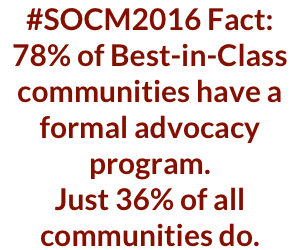By Ted McEnroe, Director of Research and Training, The Community Roundtable

Have you ever met a successful community manager who says they wish they had more to do?
Me neither. Community managers wear multiple hats, work with myriad stakeholders and are expected to understand everything from business models to technical support – often working alone or (maybe) with part-time or volunteer help. 95 percent of communities in The State of Community Management 2016 had some sort of dedicated community management staff, and 75 percent had a full-time staff member. But only 31 percent of communities say they had a team of community managers, and even in communities with tens of thousands of members, community teams are the exception, not the rule.
How do you survive? Our research highlights some real opportunities to scale yourself, ease your workload and empower your members.
Start a Champions Program
 Every community manager knows how important key members are to keep the community vibrant and engaging. But not everyone is giving your advocates the training and responsibility to tackle real tasks in the community. TheCR Network has a champions program that taps into the interests and expertise of members and gives them real opportunities to develop their skills and share knowledge. Their skills expand the knowledge base in the community, and help take the content burden off the community manager.
Every community manager knows how important key members are to keep the community vibrant and engaging. But not everyone is giving your advocates the training and responsibility to tackle real tasks in the community. TheCR Network has a champions program that taps into the interests and expertise of members and gives them real opportunities to develop their skills and share knowledge. Their skills expand the knowledge base in the community, and help take the content burden off the community manager.
Give Your Advocates Real Responsibilities, and Real Rewards
Advocacy programs are usually good about recognizing community stalwarts, but sometimes fall short of giving them other benefits and responsibilities. Nearly 90% give their advocates visual recognition in the community and 74% give them access to the community team – but many stop there. Best-in-class communities build beyond mere recognition with special opportunities to give feedback and gain access to executives, and they are also more likely to expect advocates to answer questions, test new products and organize programs.
Empower Your Members
Your advocates are key, but they’re by definition just a subset of your members. Don’t forget about “the 99%” in your community, either!
Ask their opinions: The research demonstrates that communities with formal processes for member feedback have substantially higher engagement – and finding out what’s not working for members can help you focus on the things that members really value.
Put them in charge: Best-in-class communities excel at getting members and internal experts to lead programming, not just community managers. And communities with member-led programming get higher engagement, too.
The bottom line is this: Good community managers manage their communities. Great community managers enable their communities. It’s an investment in the short-term, but worthwhile for your long-term community – and personal – health.
And we’ve got the research to prove it.
Check out the stats and gain valuable insights in The State of Community Management 2016 – available for free download now! And be sure to see how our other research can help!
